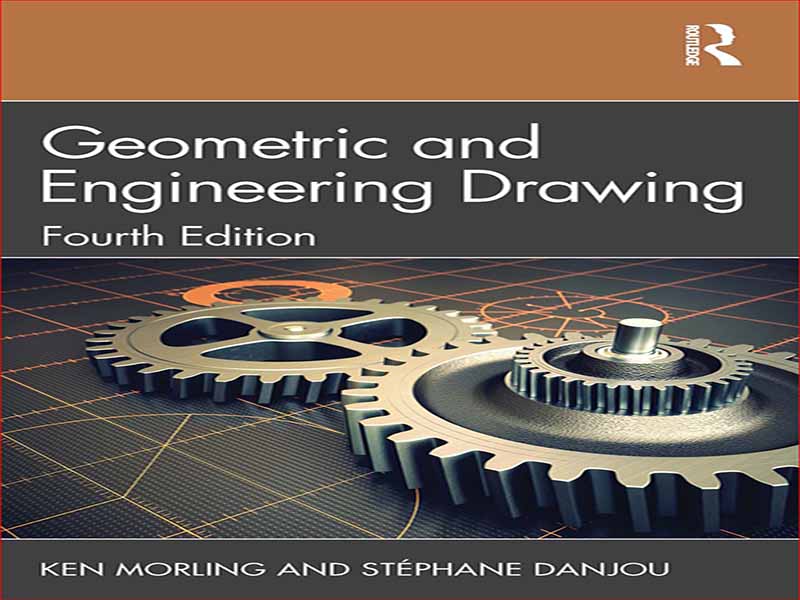نقشه های مهندسی برای چندین دهه برای انتقال اطلاعات واضح در مورد یک شی یا سیستم استفاده شده است. آنها نمایش های گرافیکی محصولات هستند و نحوه طراحی یک شی، نحوه عملکرد و نحوه تولید و مونتاژ آن را به تصویر می کشند. با ظهور برنامه های جامع طراحی به کمک کامپیوتر (CAD)، نحوه ایجاد نقشه های مهندسی به طور قابل توجهی تغییر کرد. معرفی سیستم های سه بعدی (3D) CAD به ویژه رویکرد انتقال مشخصات یک محصول فنی را متحول کرده است. اگرچه ابزار ایجاد نقشه های مهندسی با گذشت زمان به طور چشمگیری تغییر کرده است، اما اصول اساسی هنوز یکسان است. مبانی هندسه توصیفی هنوز برای بسیاری از کاربردهای ترسیم هندسی ضروری است و همان قراردادها و بهترین شیوه ها هنوز در فرآیند تهیه پیش نویس اعمال می شود. علیرغم سرعت سریع پیشرفتهای محاسباتی و احتمالات ناشی از پشتیبانی و منطقیسازی فرآیند پیشنویس، مفاهیم اساسی ترسیم هندسی و مهندسی ارتباط خود را از دست ندادهاند. امروزه ترسیم هندسی یک مهارت ضروری برای حل گرافیکی مسائل هندسی به عنوان بخشی از فاز مفهومی در فرآیند طراحی و برای درک تئوری پشت سیستم های CAD است. اگرچه روند کنونی این است که دادههای محصول را منحصراً با استفاده از مدلهای سهبعدی CAD برای تولید بدون کاغذ مخابره کنیم، اما ما با ارسال نقشههای مهندسی به دوران بازنشستگی فاصله داریم. نقشه های مهندسی، صرف نظر از اینکه از پیش نویس دستی ناشی می شوند یا به عنوان محصولات نهایی یک فرآیند مدل سازی CAD، هنوز یک شکل کارآمد از ارتباطات هستند که در همه رشته های مهندسی مورد نیاز است. این نسخه چهارم به طور کامل اصلاح شده و به شدت به روز شده است. در حالی که اصول ترسیم هندسی از نسخه های قبلی گرفته شده است، برخی از فصل های کاملاً جدید گنجانده شده است که بر هر قسمت از نقشه مهندسی تأکید می کند. نسخه جدید با مقدمه ای بر ارتباطات مهندسی و برخی اصول اولیه نقشه کشی مهندسی مانند تجهیزات پیش نویس، کنوانسیون های مورد توافق بین المللی و تکنیک های اصلی ترسیم فنی شروع می شود. فصل مربوط به ساختارهای هندسی تقریباً بدون تغییر نسبت به نسخه های قبلی است. راه حل های ترسیمی خاصی را برای بسیاری از مسائل هندسی نشان می دهد. قبل از اینکه خوانندگان را با انواع نماها در ترسیم مهندسی آشنا کنیم، روش های تجسم فضایی و مفاهیم اولیه هندسه توصیفی ارائه می شود. فصل های جدید به طور کامل به موضوعات مهم اندازه و تحمل می پردازند. علاوه بر این، ما نمایش های رایج عناصر قطعه کار و عناصر ماشینی که اغلب اتفاق می افتد و همچنین نقشه های مونتاژ و خواص آنها را معرفی می کنیم. تمام فصول مربوط به نقشه های مهندسی به آخرین توصیه های سازمان بین المللی استاندارد (ISO) به روز شده است، یعنی بهترین شیوه ها از سازمان توسعه دهنده استانداردهای بین المللی. هر قدر هم که یک دست نوشته را با دقت بررسی کنیم، خطاها وارد می شوند. اگر خوانندگانی که خطاهایی پیدا کردند، از طریق ناشران به ما اطلاع دهند، بسیار سپاسگزار خواهیم بود.
Engineering drawings have been used to convey clear information about an object or system for many decades. They are graphic representations of prod- ucts and depict how an object is designed, how it functions and how it is sup- posed to be manufactured and assembled. With the advent of comprehensive computer-aided design (CAD) programs, the way engineering drawings are cre- ated significantly changed. The introduction of three-dimensional (3D) CAD systems especially has revolutionised the approach for conveying the specifica- tions of a technical product. Although the tools for creating engineering draw- ings have changed dramatically with time, the underlying principles are still the same. The fundamentals of descriptive geometry are still necessary for many applications of geometric drawing, and the same conventions and best prac- tices still apply to the drafting process. Despite the rapid pace of computational improvements and the resulting possibilities of supporting and rationalising the drafting process, the basic concepts of geometric and engineering draw- ing have lost nothing of their relevance. Nowadays, geometric drawing is an essential skill for graphically solving geometric problems as part of a concept phase in a design process and for understanding the theory behind CAD sys- tems. Although the current trend is to communicate product data exclusively with means of 3D CAD models for paperless production, we are far away from sending engineering drawings into retirement. Engineering drawings, no mat- ter if resulting from manual drafting or as end products of a CAD modelling process, are still an efficient form of communication, required in all engineering disciplines. This fourth edition has been entirely revised and heavily updated. While the fundamentals of geometric drawing have been taken from earlier editions, some completely new chapters are included that emphasise each part of the engineering drawing. The new edition starts with an introduction to engineering communication and some basics of engineering drawing such as drafting equipment, interna- tionally agreed conventions and principal techniques of technical sketching. The chapter on geometric constructions is almost unchanged from earlier editions. It shows specific drawing solutions to many geometric problems. Before intro- ducing readers to the different types of views in engineering drawing, methods of spatial visualisation and basic concepts of descriptive geometry are pre- sented. New chapters thoroughly address the important topics of dimensioning and tolerancing. Further, we introduce common representations of workpiece elements and frequently occurring machine elements as well as assembly draw- ings and their properties. All chapters related to engineering drawing have been updated to the lat- est recommendations from the International Organization for Standardiza- tion (ISO), that is, best practices from the international standards developing organisation. However carefully one checks a manuscript, errors creep in. We shall be very grateful if any readers who find errors let us know through the publishers.
این کتاب را میتوانید از لینک زیر بصورت رایگان دانلود کنید:
Download: Geometric and Engineering Drawing




































نظرات کاربران